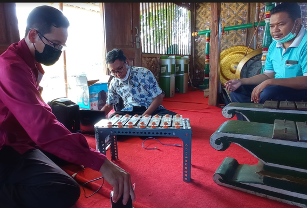Design and Build Electrical Gamelan as a Cultural Tourism Supporting Object
DOI:
https://doi.org/10.53017/uje.104Keywords:
Arduino, Culture, Electrical Gamelan, PiezoelectricAbstract
Widarapayung Wetan, Binangun District, Cilacap Regency is an innovation village entrusted by the Regional Planning, Development, Research and Development Agency (BAPPEDA) of Cilacap Regency to the Cilacap State Polytechnic. The current partner's problem is the difficulty in introducing cultural tourism to tourists visiting Widarapayung Wetan Village. One of the cultural tourism potentials in Widarapayung Wetan Village is a traditional Javanese musical instrument, namely the gamelan. Currently, gamelan cultural activities in Widarapayung Wetan Village have been actively carried out on a regular basis based on the existing schedule of activities. Therefore, in order for gamelan to become a unique attraction, it is combined with electronic technology to become an electric gamelan. The electric gamelan can be used by visitors freely to learn to play the gamelan, while the existing original gamelan can be well preserved for rehearsals and performances. The electric gamelan made are saron and demung instruments. The saron and demung blades use acrylic material. When the acrylic blade is hit/beaten with a hammer, the piezoelectric sensor will receive vibrations when the blade is hit. The vibrations will be converted into electrical energy. The electrical energy will go through the Zener diode and 1 M? resistor, and will enter into IC 4051. IC 4051 in the system functions as a multiplexer that will take only one input according to the tone of the saron or demung instrument blades that are hit. The input will be passed to Arduino for processing. Arduino will issue a sound output in the form of a tone according to the blade that is hit. The electric gamelan tone is the original tone recorded by the saron and demung instruments. The two electric gamelan instruments, saron and demung, were tested together with wiyaga and the head of the Padhang Bulan Widarapayung Wetan art studio. The next activity was socialization with members of the Padhang Bulan art studio and the village apparatus of Widarapayung Wetan.
Downloads
References
Pusat Penelitian & Pengbadian kepada Masyrakat Politeiknik Negeri Cilacap, Buku Panduan Penelitian dan PkM Edisi IV Tahun 2021. 2021.
B. Adhini Saputri, “PENGEMBANGAN ZONA GAMELAN SEBAGAI PENDUKUNG DESA WISATA LABAN (Penekanan Arsitektur Neo-Vernakular),” Universitas Muhammadiyah Surakarta, 2018.
Dinas Pariwisata dan Kebudayaan DKI Jakarta, “Gamelan Jawa , Seni Musik,” 2019.
A. Ulinuha and I. F. Putro, “TIRAI GARASI DENGAN BUKA-TUTUP OTAMATIS MENGGUNAKAN SENSOR HUJAN DAN LDR DENGAN PENGENDALI ARDUINO UNO,” 9th Univ. Res. Colloqium 2019 Univ. Muhammadiyah Purworejo, 2019.
M. Roghib, “Sistem Minimal Arduino,” 2018. [Online]. Available: https://mikrokontroler.mipa.ugm.ac.id/2018/10/02/sistem-minimal-arduino/. [Accessed: 24-Feb-2021].
R. Hidayat and Syarippudin, “Analisis Pemanfaatan Multiplexer Analog 74HC4051 pada Mikrokontroller ATMega16,” ISU Teknol. STT MANDALA, vol. 10, no. 2, 2015.
C. K. Alexander and M. N. O. Sadiku, “Fundamental of Electric Circuits,” 2009.
Widiharso, Teknik Dasar Elektronika Telekomunikasi. Kementerian Pendidikan dan Kebudayaan, 2013.
R. I. SIMBOLON, “RANCANG BANGUN TAGANING ELEKTRIK MENGGUNAKAN SENSOR PIEZOELEKTRIK DENGAN ALGORITMA FUZZY LOGIC BERBASIS ARDUINO MEGA,” UNIVERSITAS SUMATERA UTARA MEDAN, 2018.
G. S. Doni Kurniawan, Yaddarabullah, “Implementasi Internet of Things pada Sistem Irigasi Tetes dalam Membantu Pemanfatan Urban Farming,” 7 th Univ. Res. Colloq., no. June, pp. 106–117, 2018.
E. Trisnowati, “ANALISIS FREKUENSI PADA GONG LARAS SLENDRO,” Indones. J. Sci. Educ., vol. 3, no. 1, pp. 26–33, 2019.

Downloads
Published
How to Cite
Issue
Section
License
Copyright (c) 2021 Erna Alimudin, Arif Sumardiono, Zaenurrohman Zaenurrohman, Saepul Rahmat, Riyani Prima Dewi, Hera Susanti

This work is licensed under a Creative Commons Attribution-NonCommercial 4.0 International License.





